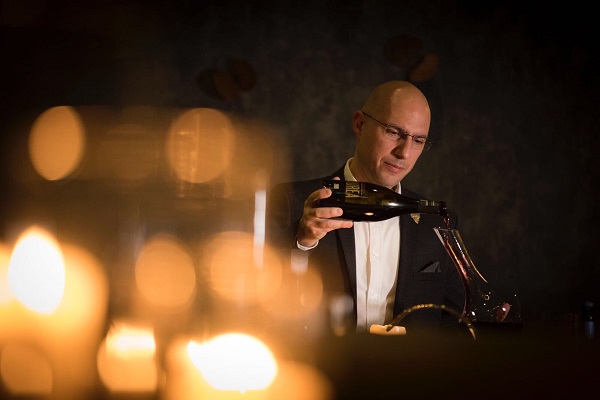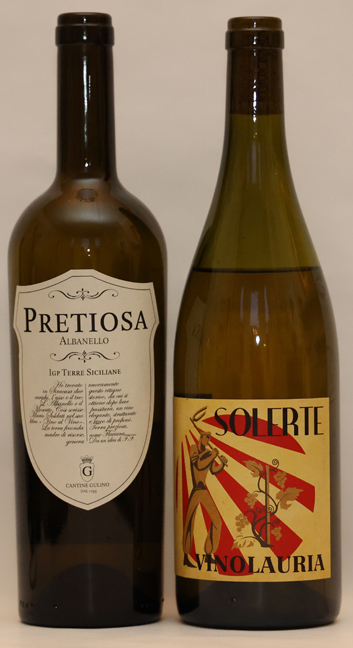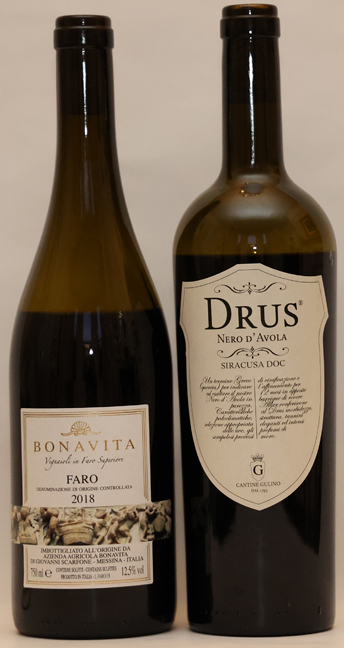25th January 2022, by Zoom
 Our first tasting of 2022 was a whole bottle tasting, with members ordering from a set of four Sicilian wines chosen by sommelier and winemaker Filippo Zito – and presented via Zoom from his Manchester base with suggestions for accompanying food pairings.
Our first tasting of 2022 was a whole bottle tasting, with members ordering from a set of four Sicilian wines chosen by sommelier and winemaker Filippo Zito – and presented via Zoom from his Manchester base with suggestions for accompanying food pairings.
So alluring were the food suggestions that many members had clearly turned the event into their own private dinner parties, to which a few Zoomed glimpses of tables covered with food and wine glasses testified!
Filippo’s range of experience makes him an ideal presenter: a winemaking heritage in south-east Sicily near Agrigento, then working in high-end restaurants across Europe to learn his trade as a sommelier (Gleneagles with Andrew Fairlie, Midland Hotel with Simon Rogan, a stage at Waterside and now a member of the Court of Master Sommeliers) before his current role as an area manager for WoodWinters, the innovative wine and spirits distributor based in Scotland.
A highly engaging presenter, Filippo shared some fascinating thoughts about wine and food matching … of which more later.
Sicilian wines went through a revolution in the 1980s – the switch from producing bulk wines designed (at least in part) to add colour and strength to northern Italian and French reds to pride in a storied heritage of indigenous grape varieties dating back at least to the time of ancient Greece and probably before.
Giacomo Tachis – the oenologist behind Sassicaia, Tignanello and the rise of Cannonau to fame – was a catalyst of this change and it was he who highlighted the potential of Nero d’Avola to be more than just a good source of (uncredited) alcohol and colour in poor northern country harvests. The changes he encouraged spurred the Etna producers such as Salvo Foti into spotting the value of Nerello Mascallese, a signature grape for modern Sicilian wines in many people’s eyes.
The whites
But we started our tasting with two fascinating white wines. The first was an Albanello from Siracusa in south-east Sicily (close to Filippo’s home territory and also the source of the Nero d’Avola we tasted later).
Sicily (close to Filippo’s home territory and also the source of the Nero d’Avola we tasted later).
No-one knows much about Albanello. It gets a third of a page in Jancis’ Wine Grapes, with the headline suggesting it’s a ’disappearing Sicilian variety once used for sweet wines’, though earlier books on Sicilian wine reckon it was highly valued in the 17th century and before. Our wine is the only 100% Albanello now produced from a historic vineyard site some 200 metres above sea level (that and the proximity of the sea keep temperatures down and help maintain freshness).
Like its fully sweet predecessors this wine – though essentially dry to off-dry – benefits from a percentage of dried grapes (‘appassimento’). Sun-dried on straw racks (like the grapes for Amarone), this gives concentration and helps bump the alcohol up to 14%. It was an intriguing balance of high acidity, a dash of minerality and that suggestion of sweetness with yellow peach and honeysuckle notes.
Brilliant with the crab with green apple and croutons that Filippo had recommended – or so said all who had that pleasure. Goat’s cheese was his other recommendation, which also went well.
Second up was a ‘natural’ Zibibbo made from 100% Muscat of Alexandria grapes fermented on the skins. In the period of Arab domination of Sicily this was a table grape prized for its sweetness and only recently has its potential as a dry wine grape been recognised. Another single vineyard wine, this one at 500 metres up in the north-west corner of the island. The winemaker, Vito Lauria, is young and his Solerté (with a striking label designed by an artist friend of Vito’s) was a deep gold in colour, with lots of body and aromas of mango, kumquat and orange blossom – but again that structure of underlying acidity to maintain freshness and bio-dynamic energy.
The primary food match here was smoked salmon with capers and Filippo noted the importance of matching the aromacity of the wine and food. Here the impact of the skin contact enabled the wine to stand up to the oily richness of the fish. Brilliant! Good words too for his second suggestion of sautéed mushrooms with garlic and parsley.
His counsel on both the whites was ‘not too cold’. Get them out of the fridge in good time and let them sit in the glass to get the best out of them with a recommended temperature of around 15C.
In response to questions, Filippo gave a quick rundown on some of the other local grapes.
Whites:
- Grillo – high acid grape, once used only in Marsala but now used in characterful dry whites, especially if it comes from the hillsides in the north east of Sicily. Filippo thinks this grape could be a good competitor to the ubiquitous Sauvignon Blanc
- Insolia – lower acidity but high in aromatics
- Catarratto – somewhere in the middle between Grillo and Insolia, with good body and acidity and blends well with Carricante to make good value Etna white. Probably a relation of Garganega.
Reds:
- Nero d’Avola (of course – and it would work with haggis… if that’s your Burns Night feast)
- Nerello Mascalese and Nerello Cappuccio (the latter a touch darker and more tannic)
- Frappato – fresh and floral. A good alternative to Beaujolais on its own but blends well with Nero d’Avola in Sicily’s only DOCG wine
- Perricone, grown mainly in western Sicily, which has a deep pigment and produces full-bodied, rather alcoholic wines. Often blended with Nero d’Avola
- Not local but showing promise is Syrah (watch out for Filippo’s own Borgo Leo wines on the WoodWinters’ site in May) whilst Pinot Noir/Nero is still a challenge, despite some promising sites high on Etna.
None of the Sicilian varieties have made much impact yet outside Italy but there are good signs that their capacity to maintain acidity even in hot climates could make a serious mark in Australia.
On to the reds…
 First up was a 2018 Nerello Mascalese-dominated blend. This was a cold vintage (by Sicilian standards) which couldn’t have harmed the refreshing notes of sour cherry and raspberry in the wine. Nerello Mascalese is thin-skinned, high acid, with a signature smoky flavour note. Drying tannins (perhaps boosted by the Capuccio in the blend) with a good acidity, but a nicely complex aroma and flavour profile – a dash of forest floor and mushrooms adding intrigue to the red fruits. Perhaps one for Pinot Noir lovers? Filippo says this wine will continue to mature for about 10 years. This is a ‘Tre Bicchieri’ wine which, alas, is in pretty short supply. Hint – the Club offer will get you in early.
First up was a 2018 Nerello Mascalese-dominated blend. This was a cold vintage (by Sicilian standards) which couldn’t have harmed the refreshing notes of sour cherry and raspberry in the wine. Nerello Mascalese is thin-skinned, high acid, with a signature smoky flavour note. Drying tannins (perhaps boosted by the Capuccio in the blend) with a good acidity, but a nicely complex aroma and flavour profile – a dash of forest floor and mushrooms adding intrigue to the red fruits. Perhaps one for Pinot Noir lovers? Filippo says this wine will continue to mature for about 10 years. This is a ‘Tre Bicchieri’ wine which, alas, is in pretty short supply. Hint – the Club offer will get you in early.
This wine comes from Faro – in the north-eastern tip on the island. Colder, clay soil in ancient terraces here rather than the more mineral Etna conditions. All organic with natural ferment and indigenous yeasts. Long skin contact – but no hint of over-extraction – and then time spent first in large oak, then in concrete and lastly another year in bottle.
Filippo had suggested wild boar terrine or duck rillettes or lentil stew – in each case the high acid works to cut through the fat in the dish. Particuarly true, this, of the solid fat of the terrine or rillettes (and see below for the rather different treatment you need for more liquid oiliness).
The last wine of the evening – alas! – was a Nero d’Avola. Tachis had early identfied this as a variety that deserved better than the standard recipe of a couple of days of skin contact and then into bulk containers and ship north fast.
The tasting wine, named Drus after the oak forest that once occupied today’s vineyard, is made just a couple of miles from the sea on the south east coast of the island. It too was complex but with a richness foreign to Nerello Mascalese. Deeper colour, a lot more tannin and more alcohol but still fresh and aromatic with notes of menthol and eucalyptus and a touch of green pepper to balance the dominant dark cherry aromas. A drier, fresher finish than its New World siblings and cousins and a brilliant match with the ‘sumptuous’ aubergines in tomato sauce with Parmesan that was Filippo’s top tip for matching (but try it as well with aged sheep’s milk cheese such as manchego or pecorino). In this case the tannins in the wine dry the oil.
Being a somm is not an easy job! You need to think not just about the food but also the customer. What are they in the market for? What might their budget be? How do enable the whole table to enjoy the match – even though they may have chosen vastly different dishes?
And Filippo’s top tip for getting the best out of the wine list? Simple! Go for the wines (and regions) that (other) people don’t know about yet. Croatia or Greece rather than northern Italy; Languedoc-Roussillon rather than Burgundy or the Rhone. Frappato rather than Beaujolais; an Etna white rather than a Chablis.
A ’tremendous tasting’ said one and all in person and on the chat. Thanks to all concerned – especially Filippo – but a big thank you also to Richard Liwicki for doing a great MC job on the night: technical fixer, generous host and brilliant question master.
The wines (prices as per the Club offer)
- Pretiosa Albanello 2020 from Cantine Gulino. IGP Terre Siciliane. 14%. £15
- Solerte Zibibbo 2020 from VinoLauria. IGP Terre Siciliane. 15%. £14.76
- Bonavita 2018, produced by Giovanni Scarfone, Faro DOC (near Messina). Blend of Nerello Mascalese (70%), Nerello Capuccio (30%) and a dash of Nocera. 12.5%. £28.80
- Drus Nero d’Avola 2017 from Cantine Gulino. Siracusa DOC. 14%. £17.40
GH: 26/1/22